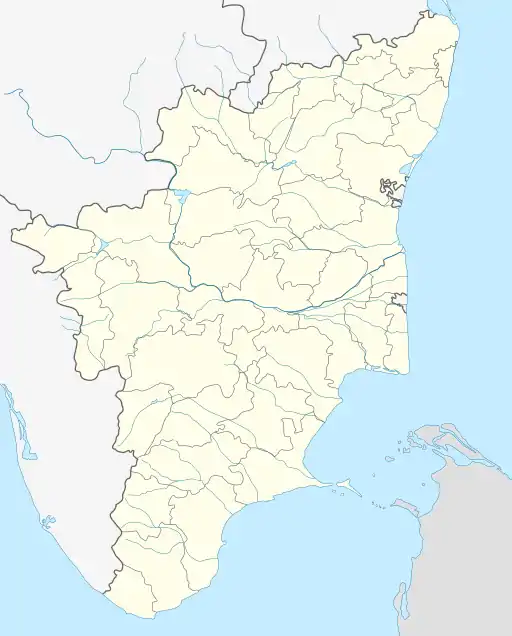Tiruvelukkai
Tiruvelukkai located in Kanchipuram in the South Indian state of Tamil Nadu, is dedicated to the Hindu god Vishnu. Constructed in the Dravidian style of architecture, the temple is glorified in the Divya Prabandha, the early medieval Tamil canon of the Azhwar saints from the 6th–9th centuries AD. It is one of the 108 Divyadesam dedicated to Vishnu, who is worshipped as Azhagiya Singar and his consort Lakshmi as Amruthavalli.
| Tiruvelukkai | |
|---|---|
 | |
| Religion | |
| Affiliation | Hinduism |
| District | Kanchipuram district |
| Location | |
| Location | Kanchipuram |
| State | Tamil Nadu |
| Country | India |
 Location in Tamil Nadu | |
| Geographic coordinates | 12°49′20″N 79°42′24″E |
| Architecture | |
| Type | Dravidian architecture |
The temple is believed to have been built by the Pallavas of the late 8th century AD, with later contributions from Medieval Cholas and Vijayanagar kings. The temple has three inscriptions on its walls, two dating from the period of Kulothunga Chola I (1070–1120 CE) and one to that of Rajadhiraja Chola (1018-54 CE). A granite wall surrounds the temple, enclosing all the shrines and two bodies of water. There is a 3-tiered rajagopuram, the temple's gateway tower, in the temple.
Azhagiya Singar is believed to have appeared to slay Hiranya, the demon king. Six daily rituals and three yearly festivals are held at the temple, of which the Krishna Janmasthami festival, celebrated during the Tamil month of Aavani (August–September), being the most prominent. The temple is maintained and administered by the Hindu Religious and Endowment Board of the Government of Tamil Nadu.
Legend

Velukkai is derived from Vel (desire) and irukkai (place of stay), meaning the place where Vishnu desired to stay, which became Velukkai from Velirukkai.[1] It is believed that the original image of the temple was east facing standing posture of Vishnu as he appeared for Bhrigu Maharishi and later appeared as Azhagiya Singar.[2] As per Hindu legend, once there was an argument between Saraswathi, the consort of Brahma and Lakshmi on superiority. They went to Indra, the king of celestial deities. Indra judged Lakshmi as superior and not satisfied with his argument, Saraswathi went to her husband, Brahma. He also chose Lakshmi to be the superior one. Saraswathi was unhappy with the decision and decided to stay away from Brahma. Brahma did a severe penance praying to Vishnu and did an Aswametha Yagna. Saraswathi was still angry that the yagna, which usually is done along with consorts was done alone by Brahma. She tried to disrupt the penance in various ways, but Vishnu interfered in all her attempts. After all the demons were killed by Vishnu, who were sent by Saraswati to destroy the yagna(penance) done by Brahma, she sent Kapalika, a demon. Lord Vishnu took the form of Narhari to kill the demon.[3]
Architecture
The presiding deity is Narasimhar (also called Mukunda Nayaka) is depicted in a seated posture facing West.[1] The temple is located close to the Tiruththanka temple in Vishnu Kanchipuram. The temple has three shrines, one each for the presiding deity Azhagiyasingar, one for his consort Amruthavalli and other for Garuda.[3]
Festivals and religious practices
The temple follows the traditions of the Thenkalai sect of Vaishnavite tradition and follows vaikanasa aagama. The temple priests perform the pooja (rituals) during festivals and on a daily basis. As at other Vishnu temples of Tamil Nadu, the priests belong to the Vaishnavaite community, a Brahmin sub-caste. The temple rituals are performed six times a day: Ushathkalam at 7 a.m., Kalasanthi at 8:00 a.m., Uchikalam at 12:00 p.m., Sayarakshai at 6:00 p.m., Irandamkalam at 7:00 p.m. and Ardha Jamam at 10:00 p.m. Each ritual has three steps: alangaram (decoration), neivethanam (food offering) and deepa aradanai (waving of lamps) for both Azhagiya Singar and Amruthavalli. During the last step of worship, nagaswaram (pipe instrument) and tavil (percussion instrument) are played, religious instructions in the Vedas (sacred text) are recited by priests, and worshippers prostrate themselves in front of the temple mast. There are weekly, monthly and fortnightly rituals performed in the temple.[4]
Religious importance
The temple is revered in Nalayira Divya Prabandham, the 7th–9th century Vaishnava canon, by Peyalvar, Bhoothathazhwar, Thirumazhisai Aazhwar and Thirumangai alvar. The Azhwars have sung praise on the different forms of Pandava Thoothar. The temple is classified as a Divyadesam, one of the 108 Vishnu temples that are mentioned in the book. Many Acharyas have also written songs on the various forms of God in this Temple.[3]
Notes
- C., Chandramouli (2003). Temples of Tamil Nadu Kancheepuram District. Directorate of Census Operations, Tamil Nadu.
- R. 2001, p. 567-8
- MS 1993, pp. 79-81
- "Sri Azhagia Singa Perumal temple". Dinamalar. 2014. Retrieved 31 May 2014.
References
- M.S., Ramesh (1993). 108 Vaishnavite Divya Desam Volume 1. Tirupati: Tirumala Tirupati Devasthanams.
- R., Dr. Vijayalakshmy (2001). An introduction to religion and Philosophy - Tévarám and Tivviyappirapantam (1st ed.). Chennai: International Institute of Tamil Studies.